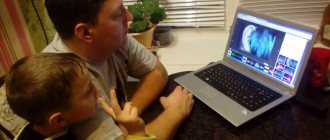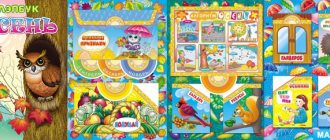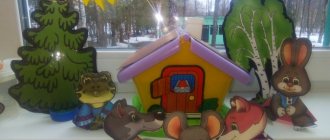Short-term project “Wintering Birds” in the second junior group (3–4 years)
Evgenia Popova
Short-term project “Wintering Birds” in the second junior group (3–4 years)
Relevance
The interaction of man with nature is an extremely pressing problem of our time. For centuries, man has been a consumer in relation to nature: he lived and used its gifts without thinking about the consequences.
The task of adults is to cultivate children’s interest in our neighbors on the planet, the birds , the desire to learn new facts about their lives, take care of them, and rejoice in the knowledge that by sharing crumbs, you can save birds from death in winter . Give children basic knowledge of what to feed birds in winter .
Working together with parents, we must create conditions for the child to communicate with the natural world and to help our feathered friends as much as possible.
Goal: to form a general understanding of preschoolers about wintering birds , their way of life, characteristic features and connections with the environment, the role of humans in the life of birds .
Tasks:
-form ideas about wintering birds ;
— create a desire to help birds in difficult winter conditions;
— to develop children’s skills in feeding birds ;
— promote the development of cognitive and creative activity, curiosity;
— broaden their horizons and enrich children’s vocabulary, develop coherent speech;
— attract parents to closer cooperation in project activities ;
— create conditions for expanding ideas about birds (replenish the developmental subject-spatial environment on the topic of the project ).
Expected results of the project :
- children’s learning about wintering birds and their young ;
— determination of the habitat;
— establishing cause-and-effect relationships between lifestyle and environment;
- children’s interest together with their parents in caring for birds , the desire to help them in the winter (making feeders, feeding birds in winter )
;
— development in children of curiosity, creative abilities, cognitive activity, and communication skills.
Project implementation period : 1.02.16- 14.02.16
1.Preparatory stage:
— determination of the project ;
— development of a long-term project ;
— creating the necessary conditions for the implementation of the project ;
— development of teaching materials, recommendations on the topic (selection of consultations for parents, etc.)
;
— preparation of attributes for events (illustrations, masks for games, fiction, creation of a card index of finger games on the topic “ Wintering Birds ”
)
2. Basic (practical)
It represents the introduction into the educational process of effective methods and techniques to expand the knowledge of preschoolers about wintering birds , their habits, and the characteristics of life in winter.
The project carried out in 3 directions:
1. Work of teachers with children;
2. Work of educators with parents;
3. Joint activities of parents and children.
Working with students
Educational areas of the project : social and communicative development, cognitive development, speech development, artistic and aesthetic development, physical development.
Forms of work: directly organized activities, conversations, observations, didactic and outdoor games, reading fiction, listening to audio recordings, productive activities.
Cognitive development:
Conversations: “What do you know about wintering birds ?”
, “How
birds differ from animals?; "Where do
the birds ?" ,
“What
birds fly to the kindergarten site?” ;
“Do you need to take care of
birds ?” ;
“What benefits do
birds ?” :
“
Birds ” ;
"Find a house for a bird
.
Examination of wintering birds in illustrations in books and magazines.
Looking at paintings: “ Birds at the feeder ”
;
"Children Feed the Birds "
.
Didactic games: “One - many”
;
“Guess by the description”
;
“What kind of
bird ?” ;
"Guess who's gone"
;
“Big and small
birds at the feeder ” ;
"Feed
the birds " ;
“Find a chick for mom”
;
“What kind of
birds are there in abundance on the tree ?” ;
“Name and show
wintering birds . ”
Solving riddles about wintering birds .
Social and communicative development:
Feeding birds during walks ; hanging feeders made by parents.
Role-playing games: “ Bird ”
;
“Invite the titmouse to visit”
;
"Bird's canteen"
.
Situational conversation: “Is it possible to pick up bird feathers?”
,
“How
do birds defend themselves ?” ;
“What does it mean to take care of
wintering birds ?” ;
"Feathered Friends"
.
Artistic and aesthetic development:
Drawing: “We invite bullfinches to eat rowan quickly”
.
Coloring book: "Sparrow"
,
“Bullfinches on a branch”
,
“Titmouse and Rowanberry”
, etc.
Modeling: “Birds in nests”
.
Listening to the audio recording: “ Bird ”
.
Speech development:
Conversations: “What birds did I see while walking with my parents?”
;
“What does a sparrow eat?”
,
“Feeders are different”
;
“Why you need to feed
birds . ”
Learning the poem by A. Ignatova “Dawn with a scarlet tassel...”
.
Reading: S. Marshak “Where did the sparrow have dinner?”
;
Z. Aleksandrova “Guli-Guli”
;
N. Hilton “Birdhouse”
;
V. Zvyagin “Sparrow”
;
T. Evdoshenko “Take care of
the birds ” ;
V. Berestov “Sparrows”
;
A. Barto "Sparrow"
.
Word games: “Name it kindly”
;
“Who will be who?”
.
Physical development:
Outdoor games: “Birds are flying”
;
"The Crows and the Little Dog"
;
"Birds in Nests"
;
"Sparrows and the car"
;
"Cat and Sparrows"
.
Finger games: “Sparrows - little sparrows”
;
"Bird Feeder"
;
“The bullfinch sat on a branch”
;
"Magpie"
;
“The bird flaps its wings
.
2. Work of educators with parents.
Consultations: “How to help birds survive the winter ”
;
“How and from what you can make a bird ”
.
Individual conversations: “Do you discuss the topic of the week with your child at home?”
.
Memo for parents: “Feed the birds ”
.
During this project, campaign was implemented: “Feed the birds ”
.
3. Work of parents and pupils.
Participation in the “Bird Canteen”
bird
feeders ) ;
as well as feeding birds during walks .
Collecting food for birds .
watching outside the kindergarten .
3. Final stage. Summarizing.
As a result of this project “ Wintering Birds ”
parents and children became interested in joint activities;
Favorable conditions were also created for the formation in younger preschoolers of a holistic understanding of the life of wintering birds , for instilling in children a caring attitude towards nature;
were formed to develop children's curiosity and creative abilities. The subject-development environment in the group The pupils and their parents took an active part in helping the birds in difficult winter conditions.
Short-term project in the 2nd junior group. Wintering birds project (junior group) on the topic
Short-term project in the 2nd junior group. Wintering birds
Feed the birds in winter! Let flocks of people flock to your porch from all over, as if it were home. Their food is not rich. A handful of grain is needed, One handful - and they won’t be afraid of winter... A. Yashin Type of project: information-oriented Type of project: short-term, family, group Implementation period: from 01/30/2017 to 02/17/2017
Project participants: children of the second junior group, parents, teachers. Relevance of the project: In the cold season, wintering birds face vital questions: how to feed themselves. The available food is becoming significantly less, but the need for it is increasing. Sometimes natural food becomes practically unavailable, so many birds cannot survive the winter and die. The task of adults is to cultivate children's interest in our smaller friends - birds, the desire to learn new facts about their lives, take care of them, and rejoice in the knowledge that by sharing crumbs, you can save birds from death in winter. To give children basic knowledge about what to feed birds in winter. Project goal: To develop moral feelings in preschoolers through environmental education with access to productive activities. Creating optimal conditions for the development of creative activity and a positive emotional state in a child through the organization of joint cognitive and productive work activities. Problems: Lack of children's knowledge about wintering birds. There is no skill in feeding birds in the winter season. Project objectives: Educational: • To consolidate the previously acquired knowledge of preschoolers about wintering birds, their way of life, habits, connections with the environment, the role of humans in the lives of birds. • Replenish existing knowledge with new information. • Teach children how to properly feed birds. Developmental: • Promote the development of cognitive and creative activity, curiosity. • Expand children's horizons and enrich their vocabulary, develop coherent speech. Educational: • Develop a caring attitude towards birds, a desire to help in difficult winter conditions. • Instill a love for nature and cultivate a caring attitude towards it. • Strengthen child-parent relationships Expected results of the project: - To interest children together with their parents in caring for birds, the desire to help them in the winter (making feeders, feeding birds in winter). — Joint activities will help strengthen parent-child relationships. — Development of curiosity, creativity, cognitive activity, and communication skills in children. Project stages: 1. Preparatory stage. — Determining the level of children’s knowledge about wintering birds. — Defining the project theme, objectives, strategies and mechanisms. — Collection of information on this topic. — Creation of the necessary conditions for the implementation of the project. 2. Main stage. Project implementation. It represents the introduction into the educational process of effective methods and techniques to expand the knowledge of preschoolers about wintering birds, their habits, and the characteristics of life in winter. The project was carried out in three directions: - work of teachers with children; - independent activity of children; - joint activities of parents and children.
Working with children to solve project problems:
1. Work of teachers with children Conversations: “What do you know about wintering birds?” Purpose: To identify the level of children’s knowledge about wintering birds. “Birds Menu” Purpose: To introduce children to the types of feeding birds in winter. “Winter Guests” Purpose: To expand children’s understanding of wintering birds. “Why help birds in winter” Purpose. To foster a caring attitude towards living nature. Examination of wintering birds in illustrations in books and magazines. Purpose: To clarify ideas about wintering birds, To activate children’s vocabulary. Examination of narrative paintings and photographs Purpose: To clarify ideas about wintering birds. Activate children's vocabulary. Compilation of stories based on illustrations Goal: Enrich and activate children's vocabulary. Form coherent speech. Learning poetry Goal: To teach listening to a literary text, to develop memory. Activate and enrich children's vocabulary. Learning finger games Goal: To develop hand motor skills. Activate children's vocabulary. Reading fiction (folklore, poetry, stories) Purpose: To develop interest in the need for reading. Involvement in familiarization with various forms of fiction. V. Zvyagina “Sparrow”, S. A. Yesenin “Winter Sings, Calls”, T. Evdoshenko “Take Care of the Birds”, “Winter Guests” Y. Nikonov “Sparrow”, “Where the Sparrow Dined” / from the series “Children in a Cage” ”, “Smart Bird”.Designing a corner of a book (selection of books about birds) Purpose: To expand children’s understanding of wintering birds, their characteristics, habits. Cultivating a love for feathered friends. Listening to the audio recording “Voices of the Winter Forest” Purpose: To learn to listen to music, to distinguish the voices of birds. Didactic games “Collect a bird”, “What kind of bird? ”, “Who is screaming?”, “Cut pictures”, “Whose shadow?”, “Small - small - less”, “Guess by touch”, “Who is further, who is closer?”, “Who is sitting where?” , “Guess who’s missing?”, “Feed the birds.” Goal: development of completeness of visual perception, the ability to systematically and purposefully examine an object, highlight the main features, and put together a whole picture from parts. Role-playing games “Invite the titmouse to visit”, “Bird Hospital” Purpose: To cultivate a desire to empathize and help feathered friends. 2. Independent activity of children: Examination of wintering birds in illustrations in books and magazines Examination of plot paintings and photographs Purpose: Clarify ideas about wintering birds. Activate children's vocabulary. Printed board games, insert games, cut-out pictures, stencils Purpose: Attracting children to independent activities. Walks: Bird watching. Bird tracks. Conversations about wintering birds. Outdoor games • “Crows” • “Birds” • “Sparrows and the cat”
Excursion around the territory of the kindergarten Opening of the “Bird Canteen” Purpose: To develop a caring attitude towards birds, a love for wildlife and a desire to take care of birds; strengthening parent-child relationships. Feeding birds Goal: To create a desire to take care of our feathered friends. 3. Joint activities of parents and children Competition “Bird's Dining Room” Goal: Involving parents to participate in the project, strengthening parent-child relationships. Education of moral feelings. Collecting food for birds Goal: To attract parents to the problem of feeding birds in winter. Strengthening parent-child relationships.
As a result of the work, children will receive a lot of new information about the birds that winter near us. They learn about the life of birds, their differences, habits, and habitat features in winter. Find out what you can feed birds and what you can’t. They will take part in collecting food for birds. Together with parents they will make feeders. Parent-child relationships will be strengthened. But the main result of the project is that children will learn that our feathered friends will not be able to survive the winter if we do not help them. Children will become kinder and more responsive.
Short-term project in the 2nd junior group.
Wintering birds



